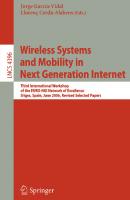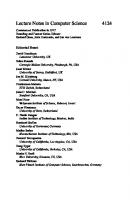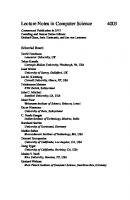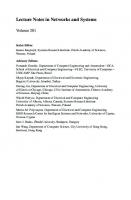Wireless Systems and Mobility in Next Generation Internet: Third International Workshop of the EURO-NGI Network of Excellence, Sitges, Spain, June ... (Lecture Notes in Computer Science, 4396) 3540709681, 9783540709688
This book is the thoroughly refereed post-proceedings of the Third International Workshop on Wireless and Mobility organ
130 93 10MB
English Pages 280 Year 2007
Table of contents :
Title
Preface
Organization
Table of Contents
Performance Analysis of Wireless Multihop Data Networks
Introduction
Model
Network Topology and Interference
Scheduling Algorithms
The Rate Region
The Impact of Congestion Control
Rate Region: Centralized Scheduling
Rate Region: Distributed Scheduling
Slot-Level Dynamics
Packet-Level Dynamics
Examples
Impact of the Greedy Behavior of the Congestion Control Algorithm
Further Examples
Conclusion
On the Shaping Introduced by IEEE 802.11 Nodes in Long-Range Dependent Traffic
Introduction
LRD in Network Traffic
Long-Range Dependence
LRD in Network Traffic
Estimating LRD with the Discrete Wavelet Transform
Wavelet-Based Analysis of LRD Signals
Related Work
Overview of IEEE 802.11
Scenarios
Topology Scenarios
Configuration
Traffic Sources and Transport Protocols
Propagation Models
Maximum Throughput in IEEE 802.11
Packet Error Ratio (PER) and Bit Error Ratio (BER)
Results and Analysis
Scenario 1 - Simulation
Scenario 1 - Testbed
Scenario 2 - Testbed
Scenario 3 - Testbed
Conclusions
Measurements of IEEE 802.11g-Based Ad-Hoc Networks in Motion
Introduction
Related Work
Scenarios
Meta-data Based Approach
Experiments
Toolbox
Experimental Setup
Experiments and Results
Conclusions
TrafficNet: A L2 Network Architecture for Road-to-Vehicle Communication
Introduction
Related Work
The TrafficNet Architecture
Scalability Support
Hierarchy-Limitations Support
Mobility Support
Intra-handovers
Inter-handovers
Testing
Circulatory Routes
Data Traffic
Future Work
Conclusion
A Protocol Stack for Cooperative Wireless Networks
Introduction
Related Work
System Assumptions
Cooperative Relaying
Performance of Cooperative Relaying
Analytical Results
Simulation Results
Concluding Remarks
References
Cross Layer Routing and Medium Access Control with Channel Dependant Forwarding inWireless Ad-Hoc Networks
Introduction
On Demand Multpath Link State Routing
Multipath Power and Interference Control
Diversity and Relaying Node Selection
Extended Multi Path Power Control Mac Protocol
Next Hop Selection Procedure
Lite Multi Path Power Control Mac Protocol
Simulations
Discussion and Conclusion
An Energy-Efficient Low-Latency Multi-sink MAC Protocol for Alarm-Driven Wireless Sensor Networks
Introduction
Related Work
Tone-Propagated MAC (TP-MAC)
Synchronization / Re-synchronization
Multiple Sink Nodes
Analytical Model
Results
Conclusions
References
Adaptive QoS Reservation Scheme for Ad-Hoc Networks
Introduction
Bandwidth Reservation for QoS Provisioning
The Basis of Bandwidth Reservation
The Maximum Available Bandwidth in Each Mobile Node
The Call Admission Control
Using MAC Information to Adapt
Simulation
Conclusion
DiffServ in Ad Hoc Networks
Introduction
Simulation Setup
Results
Aggressive Best-Effort Traffic
Fairness
Conclusions
Analytical Evaluation of the Overhead Generated by a Routing Scheme with Subnets for MANETs
Introduction
Related Work
Network Model
Model Assumptions
Model Notation
Routing Scheme Description
Subnet Formation
Inter-subnet Routing Protocol
Intra-subnet Routing Protocol
Packet Forwarding
Mobility Management
Performance Evaluation
Hello Protocol
Subnet Formation and Maintenance
Acquiring Topology Data
Link State Change
Location Registration and Maintenance
Conclusions
References
Appendix
Framework for Resource Allocation in Heterogeneous Wireless Networks Using Game Theory
Introduction
Game Theory Primer
User Side: Routing/Load-Balancing
User Utilities
Non-cooperative Routing
Cooperative Routing
Network Side: Admission Control and Pricing
Cooperative Case
Non-cooperative Case
Optimal Strategies
Performance Metrics
Conclusion
On the Performance of Mobile IP in Wireless LAN Environments
Introduction and Related Work
Mobility Within the Internet Protocol
Mobile IPv4
Mobile IPv6
Bidirectional Tunneling and Route Optimization
Fast Handovers for Mobile IPv6
Simulation Setup
Simulation Results
Agent Advertisement Interval of Mobile IPv4
Duplicate Address Detection
Mobility Detection Factor
Fast Mobile IPv6
Fast Mobile IPv6 with Route Optimization
Conclusion
Network Selection Box: An Implementation of Seamless Communication
Introduction
Foundations of Mobility and Seamless Communication
Network Selection Box (NSB) Architecture
Implementation and Communication Management
Performance Evalutation of the NSB
Measurement Setup
Measurements and Results
Handover Delays
Relative Overhead vs. Frame Size Ration
Conclusion and Outlook
Joint Connection and Packet Level Analysis in W-CDMA Radio Interface
Introduction
SystemandTrafficModels
UMTS Capacity: Basic Relations and Definitions
Traffic Model
Mathematical Model and Algorithms
Connection Level
Packet Level
Analysis of Results
Performance of a Traffic Mix
Analyzing Trends by Load Change
Adjustment of Loss Rates at Packet Level
Behavior Analysis When Changing Activity Factor
Conclusions
References
Trunk Reservation in Multi-service Networks with BPP Traffic
Introduction
Traffic Model
Algorithm for Multi-rate Systems
Trunk Reservation
Performance Measures
Examples and Comparisons
Multi-slot Poisson Traffic
Single-Slot BPP Traffic
Multi-slot BPP Traffic
Complexity
Conclusions
Feasible Load Regions for Different RRM Strategies for the Enhanced Uplink in UMTS Networks
Introduction
Related Work
Introduction to the Enhanced Uplink
Radio Resource Management for the E-DCH Best Effort Service
Interference and Load Model
Resource Assignment to E-DCH Users
Feasible Load Region and Boundaries
Numerical Example
Conclusion and Outlook
On the Interactions Between TCP Westwood and the AODV Routing Protocol
Introduction
Description of the Testbed
Overview of AODV
Overview of TCP Westwood
Parameters of the Routing Protocol
Analysis of the Results
Sudden Dropping of the Links
Slow Degradation of One Link
Conclusions
Stability and Dynamics of TCP-NCR(DCR) Protocol in Presence of UDP Flows
Introduction
TCP in Wireless Environment, TCP-DCR
Conclusions
Optimization Models for Application Migration to Support Mobile Thin Clients
Introduction
Related Work
Application Migration
Architecture
Sample Scenario
Server Selection Algorithms
Theoretical Model
Heuristics
Experimental Results
Conclusion and Future Work
Author Index
Title
Preface
Organization
Table of Contents
Performance Analysis of Wireless Multihop Data Networks
Introduction
Model
Network Topology and Interference
Scheduling Algorithms
The Rate Region
The Impact of Congestion Control
Rate Region: Centralized Scheduling
Rate Region: Distributed Scheduling
Slot-Level Dynamics
Packet-Level Dynamics
Examples
Impact of the Greedy Behavior of the Congestion Control Algorithm
Further Examples
Conclusion
On the Shaping Introduced by IEEE 802.11 Nodes in Long-Range Dependent Traffic
Introduction
LRD in Network Traffic
Long-Range Dependence
LRD in Network Traffic
Estimating LRD with the Discrete Wavelet Transform
Wavelet-Based Analysis of LRD Signals
Related Work
Overview of IEEE 802.11
Scenarios
Topology Scenarios
Configuration
Traffic Sources and Transport Protocols
Propagation Models
Maximum Throughput in IEEE 802.11
Packet Error Ratio (PER) and Bit Error Ratio (BER)
Results and Analysis
Scenario 1 - Simulation
Scenario 1 - Testbed
Scenario 2 - Testbed
Scenario 3 - Testbed
Conclusions
Measurements of IEEE 802.11g-Based Ad-Hoc Networks in Motion
Introduction
Related Work
Scenarios
Meta-data Based Approach
Experiments
Toolbox
Experimental Setup
Experiments and Results
Conclusions
TrafficNet: A L2 Network Architecture for Road-to-Vehicle Communication
Introduction
Related Work
The TrafficNet Architecture
Scalability Support
Hierarchy-Limitations Support
Mobility Support
Intra-handovers
Inter-handovers
Testing
Circulatory Routes
Data Traffic
Future Work
Conclusion
A Protocol Stack for Cooperative Wireless Networks
Introduction
Related Work
System Assumptions
Cooperative Relaying
Performance of Cooperative Relaying
Analytical Results
Simulation Results
Concluding Remarks
References
Cross Layer Routing and Medium Access Control with Channel Dependant Forwarding inWireless Ad-Hoc Networks
Introduction
On Demand Multpath Link State Routing
Multipath Power and Interference Control
Diversity and Relaying Node Selection
Extended Multi Path Power Control Mac Protocol
Next Hop Selection Procedure
Lite Multi Path Power Control Mac Protocol
Simulations
Discussion and Conclusion
An Energy-Efficient Low-Latency Multi-sink MAC Protocol for Alarm-Driven Wireless Sensor Networks
Introduction
Related Work
Tone-Propagated MAC (TP-MAC)
Synchronization / Re-synchronization
Multiple Sink Nodes
Analytical Model
Results
Conclusions
References
Adaptive QoS Reservation Scheme for Ad-Hoc Networks
Introduction
Bandwidth Reservation for QoS Provisioning
The Basis of Bandwidth Reservation
The Maximum Available Bandwidth in Each Mobile Node
The Call Admission Control
Using MAC Information to Adapt
Simulation
Conclusion
DiffServ in Ad Hoc Networks
Introduction
Simulation Setup
Results
Aggressive Best-Effort Traffic
Fairness
Conclusions
Analytical Evaluation of the Overhead Generated by a Routing Scheme with Subnets for MANETs
Introduction
Related Work
Network Model
Model Assumptions
Model Notation
Routing Scheme Description
Subnet Formation
Inter-subnet Routing Protocol
Intra-subnet Routing Protocol
Packet Forwarding
Mobility Management
Performance Evaluation
Hello Protocol
Subnet Formation and Maintenance
Acquiring Topology Data
Link State Change
Location Registration and Maintenance
Conclusions
References
Appendix
Framework for Resource Allocation in Heterogeneous Wireless Networks Using Game Theory
Introduction
Game Theory Primer
User Side: Routing/Load-Balancing
User Utilities
Non-cooperative Routing
Cooperative Routing
Network Side: Admission Control and Pricing
Cooperative Case
Non-cooperative Case
Optimal Strategies
Performance Metrics
Conclusion
On the Performance of Mobile IP in Wireless LAN Environments
Introduction and Related Work
Mobility Within the Internet Protocol
Mobile IPv4
Mobile IPv6
Bidirectional Tunneling and Route Optimization
Fast Handovers for Mobile IPv6
Simulation Setup
Simulation Results
Agent Advertisement Interval of Mobile IPv4
Duplicate Address Detection
Mobility Detection Factor
Fast Mobile IPv6
Fast Mobile IPv6 with Route Optimization
Conclusion
Network Selection Box: An Implementation of Seamless Communication
Introduction
Foundations of Mobility and Seamless Communication
Network Selection Box (NSB) Architecture
Implementation and Communication Management
Performance Evalutation of the NSB
Measurement Setup
Measurements and Results
Handover Delays
Relative Overhead vs. Frame Size Ration
Conclusion and Outlook
Joint Connection and Packet Level Analysis in W-CDMA Radio Interface
Introduction
SystemandTrafficModels
UMTS Capacity: Basic Relations and Definitions
Traffic Model
Mathematical Model and Algorithms
Connection Level
Packet Level
Analysis of Results
Performance of a Traffic Mix
Analyzing Trends by Load Change
Adjustment of Loss Rates at Packet Level
Behavior Analysis When Changing Activity Factor
Conclusions
References
Trunk Reservation in Multi-service Networks with BPP Traffic
Introduction
Traffic Model
Algorithm for Multi-rate Systems
Trunk Reservation
Performance Measures
Examples and Comparisons
Multi-slot Poisson Traffic
Single-Slot BPP Traffic
Multi-slot BPP Traffic
Complexity
Conclusions
Feasible Load Regions for Different RRM Strategies for the Enhanced Uplink in UMTS Networks
Introduction
Related Work
Introduction to the Enhanced Uplink
Radio Resource Management for the E-DCH Best Effort Service
Interference and Load Model
Resource Assignment to E-DCH Users
Feasible Load Region and Boundaries
Numerical Example
Conclusion and Outlook
On the Interactions Between TCP Westwood and the AODV Routing Protocol
Introduction
Description of the Testbed
Overview of AODV
Overview of TCP Westwood
Parameters of the Routing Protocol
Analysis of the Results
Sudden Dropping of the Links
Slow Degradation of One Link
Conclusions
Stability and Dynamics of TCP-NCR(DCR) Protocol in Presence of UDP Flows
Introduction
TCP in Wireless Environment, TCP-DCR
Conclusions
Optimization Models for Application Migration to Support Mobile Thin Clients
Introduction
Related Work
Application Migration
Architecture
Sample Scenario
Server Selection Algorithms
Theoretical Model
Heuristics
Experimental Results
Conclusion and Future Work
Author Index

- Author / Uploaded
- Jorge García-Vidal (editor)
- Llorenc Cerdà-Alabern (editor)









